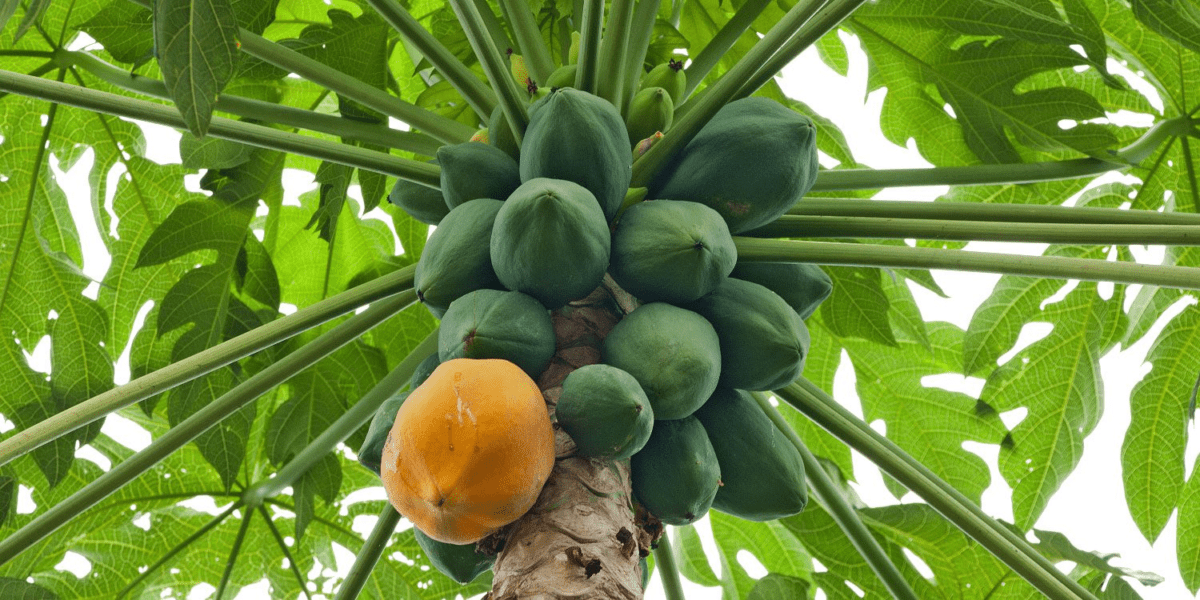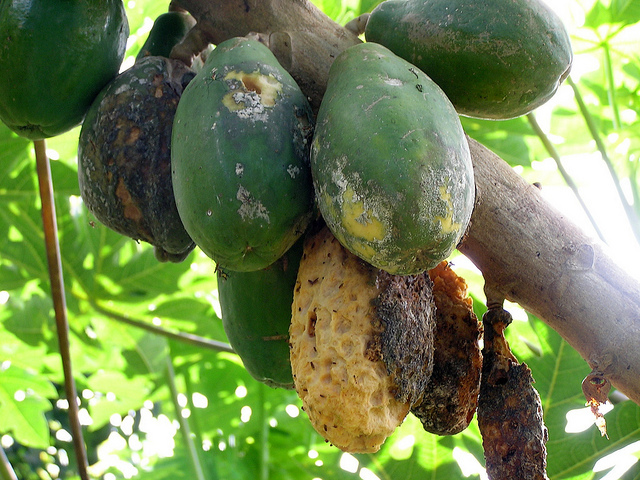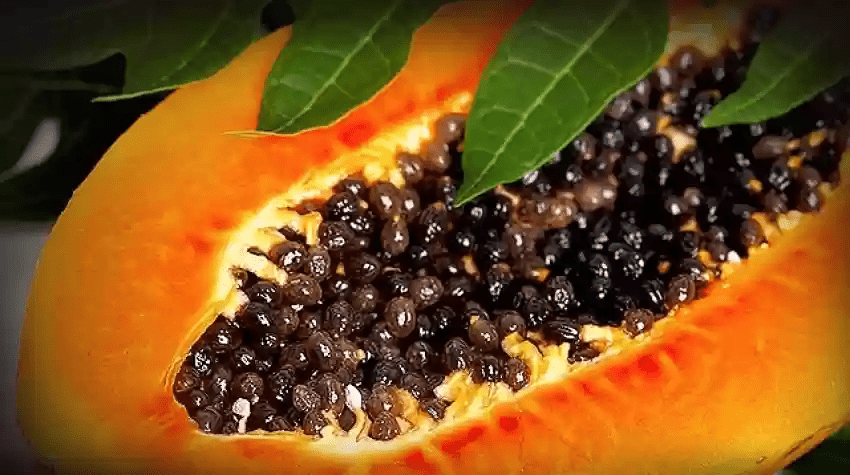Pawpaw (Carica Papaya), belongs to a small and somewhat unusual family with four genera. Three of these are found in tropical and subtropical America, while one is found in Africa. The species Carica papaya is part of this family.
Pawpaw is typically a small tree with clusters of leaves at the top. The leaves are spirally arranged and do not have stipules. Pawpaw is often dioecious, meaning that individual plants are either male or female.
Origin and Distribution
Carica papaya has never been found in the wild but is believed to have originated in southern Mexico and Costa Rica. From there, it has spread to tropical and subtropical regions around the world.
Uses of Pawpaw

Ripe pawpaw fruits are commonly eaten fresh, often at breakfast or as a dessert, and used in fruit salads. The fruit can also be used to make soft drinks, jam, ice cream flavoring, crystallized fruit, and canned in syrup. Unripe fruits are cooked as a substitute for mango or apple sauce.
Papain, a proteolytic enzyme similar to pepsin, is derived from the dried latex of immature fruits. It is used in meat tenderizers, chewing gum, cosmetics, digestive aids, the tanning industry, and in processes like degumming natural silk and making wool shrink-resistant.
Young pawpaw leaves can be eaten as spinach, and sweetmeat is made from the flowers. The leaves and young fruits are also used to tenderize meat. In some countries, pawpaw seeds are used as a vermifuge, counter-irritant, and abortifacient. Pawpaw fruits are believed to have medicinal properties for conditions like fibroids, tuberculosis, and malaria.
Read Also: The PawPaw/Papaya Ovary: Economic Importance, Uses, and By-Products
Varieties
There are several named cultivars of pawpaw, but they are difficult to maintain in dioecious plants. The hermaphrodite variety Solo, introduced from Barbados, is one of the best. Its fruits are pyriform, about 10 x 15cm, and weigh around 2kg.
Ecology
Pawpaw is a tropical plant that grows in latitudes up to 32°N and S. It is easily killed by frost but produces good crops near the equator at elevations up to about 1,700 meters.
Pawpaw requires full sun, but windbreaks should be provided as low temperatures result in poor-quality fruit. The plant thrives in well-drained, fertile soil with a pH of 6-6.5 and cannot tolerate waterlogging, therefore in dry regions, irrigation is necessary.
Fruits
Pawpaw fruits are fleshy berries, 7-30 cm long, and can weigh up to 9 kg. They vary in shape from ovoid-oblong to nearly spherical. The skin is thin, smooth, and turns yellowish-orange when ripe. The flesh is edible, with a butter-like consistency and a mild, pleasant flavor, while the central cavity is five-angled.
Seeds
The seeds are numerous, arranged in five rows along the interior wall of the ovary. They are spherical, about 5 mm in diameter, black or grayish, wrinkled, and enclosed in a gelatinous coating. The embryo is median and straight, with ovoid, flattened cotyledons surrounded by fleshy endosperm.
There are about 20 dried seeds per gram, however, before planting, the gelatinous envelope should be removed from the seeds. Air-dry the seeds to retain viability for 2-3 years. Germination takes 2-3 weeks and is epigeal.
Chemical Composition
The edible portion of fresh pawpaw fruit contains approximately:
- 88% water
- 10% sugar
- 0.5% protein
- 0.1% fat
- 0.1% acids
- 0.6% ash
- 0.7% fiber
Pawpaw is rich in vitamin A and contains some vitamin C. The latex contains enzymes papain and chymopapain, which have protein-digesting and milk-clotting properties.
Propagation
Pawpaw is usually propagated by seed, seeds can be planted in wooden flats placed in the sun. After 3-4 weeks, seedlings are transplanted into containers or polythene bags. At 8-10 weeks, when seedlings are 15-20cm high, they are transplanted to the permanent orchard site.
Alternatively, seeds can be sown in nursery beds at a depth of 15 cm, with a spacing of 10 x 2.5cm. About 2,400 seedlings are needed to plant one hectare. For papain production, seeds are usually planted directly at stake with 10-30 seeds per hill.
After germination, thin to about five plants per hill, and after six months, determine the sex at flowering. Ultimately, leave one female plant per hill and one male plant for every 25-100 female plants.
For hermaphrodite cultivars like Solo, remove female plants to ensure uniform fruit size and shape. Pawpaw can also be propagated vegetatively by cutting or grafting, but this is not economical and is not recommended for commercial production.
Read Also: How to Process, Package, and Export Papayas (Pawpaw)
Field Establishment
The usual spacing for pawpaw trees is 2-3 meters apart, and transplants may need to be watered and shaded with bracken or other material. After cultivation, limit care to weed control. Intercropping with vegetables or legumes is allowed before the canopies are established. Mulching is beneficial for moisture retention, especially during the initial stages.
Good responses are obtained with organic manure and nitrogenous fertilizer, such as NPK 15:15:15, at a rate of 0.9 kg per mature tree. Pawpaw trees begin bearing fruit at 9-14 months. While pawpaw trees can theoretically live for 25 years, their productive life is usually no more than three years.
Harvesting
For fresh fruit, harvest pawpaw when the first traces of yellow appear on the skin, and the fruit will ripen in 4-5 days. Use a sharp knife to cut the fruits. Yields per tree vary from 30-150 fruits per year, producing up to 35 tonnes of marketable fruit per hectare.
Pests and Diseases

The most serious disease affecting pawpaw is mosaic virus, which stunts the plants and causes yellow mottling and leaf distortion, eventually leading to the tree’s death. In some parts of Nigeria, this virus makes it nearly impossible to grow pawpaw. The virus is spread by Aphis spp., and in Hawaii, a major pawpaw-producing region, by Myzus spp.. The bunchy-top virus is spread by the leafhopper Empoasca papaya.
Pythium spp. causes collar and foot rot when pawpaw is grown under waterlogged conditions. Anthracnose Colletotrichum spp. causes spotting of ripe fruits. Mites, birds, and other pests also damage the fruits.
Production
Most pawpaw crops in tropical regions are consumed locally because the fruits are difficult to transport over long distances. Fresh fruits are exported by air and cold storage from Hawaii to the United States, but few reach other temperate countries. Canning of pawpaw is increasing, and this market will likely grow.
Tanzania is the leading producer of pawpaw globally, with a maximum production of about 200,000 tons annually. Smaller quantities are produced in Uganda. Nigeria’s production does not meet the domestic demand in large cities. The United States is the chief importer of papain, and the market is sensitive to overproduction.
In summary, pawpaw belongs to the small family Caricaceae, with four genera. The species Carica papaya is cultivated throughout the tropics for its edible fruits, which are used in various food products, soft drinks, and desserts. Unripe fruits are cooked as a substitute for marrow and apple sauce.
Papain, derived from pawpaw latex, is a proteolytic enzyme used in meat tenderizing and other applications. Young pawpaw leaves can be eaten as spinach, and the seeds have medicinal uses. Pawpaw can be propagated either by seeds, cuttings, or grafting.
Read Also: Improve Your Soil: Composting Facts to Create Nutrient-Dense Soil

